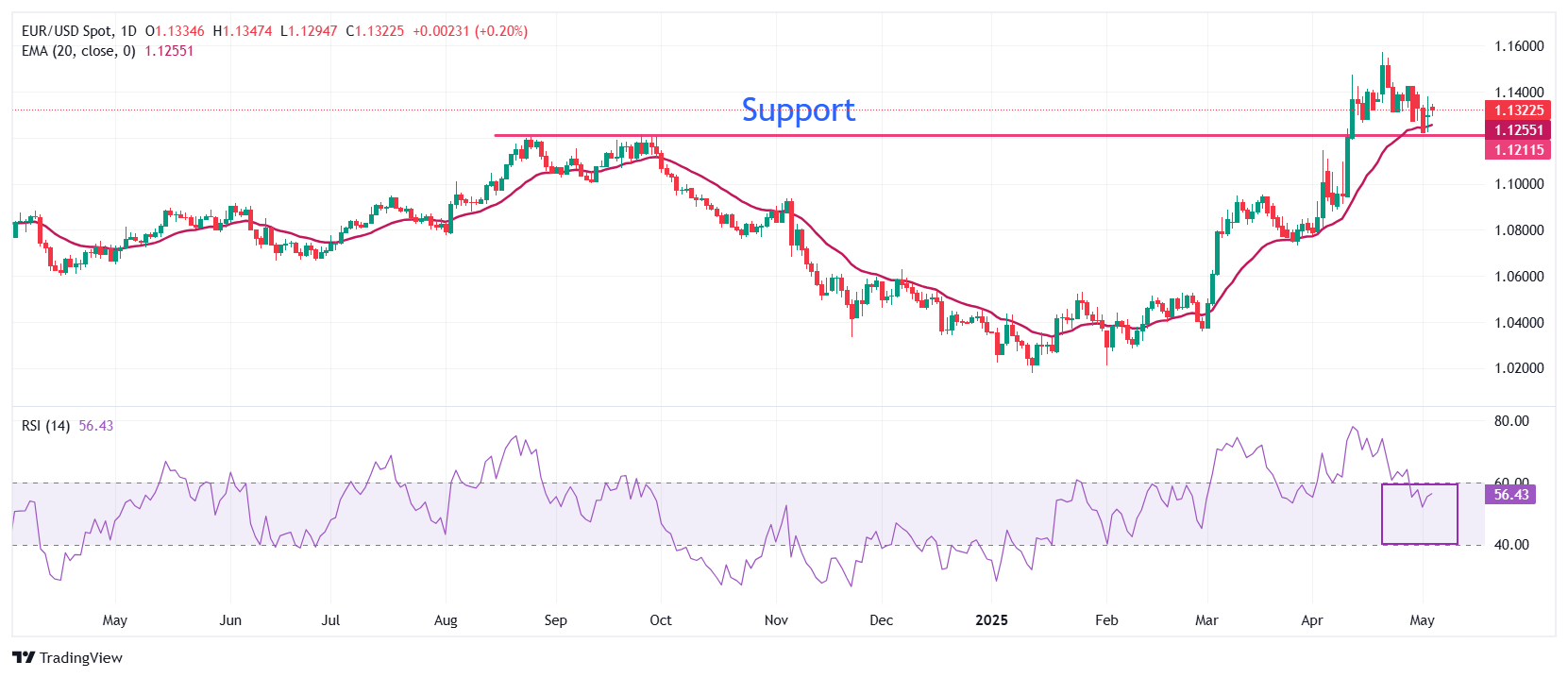EUR/USD advances as US Dollar slumps, Fed policy hogs limelight
- EUR/USD moves higher to near 1.1350 as the US Dollar faces selling pressure ahead of the Fed’s monetary policy meeting on May 6-7.
- US President Trump said he is confident about closing trade deals this week.
- The ECB is expected to continue lowering interest rates despite the increase in Eurozone inflation in April.
EUR/USD trades slightly higher to near 1.1350 during the European trading hours on Monday, further gaining ground after touching a three-week low of 1.1265 late last week. The major currency pair gains at the expense of the US Dollar (USD). The Euro (EUR) trades broadly flat while traders are increasingly confident that the European Central Bank (ECB) will reduce interest rates again in the June policy meeting despite hotter-than-expected Eurozone Harmonized Index of Consumer Prices (HICP) data for April.
The data showed on Friday that the core HICP – which excludes volatile components like food, energy, alcohol, and tobacco – grew at a faster pace of 2.7% compared to estimates of 2.5% and the March reading of 2.4%. In the same period, the headline HICP rose steadily by 2.2% on year, faster than estimates of 2.1%.
Traders continue to bet on more interest rate cuts from the ECB as they are more concerned about the Eurozone economic outlook due to the fallout of Donald Trump’s protectionist policy than the slight increase in inflationary pressures.
On Friday, ECB Vice President Luis de Guindos expressed confidence in an interview with Austria’s Die Presse newspaper that the central bank could continue reducing interest rates, Reuters reported. “It depends on how inflation develops. But we can be optimistic here,” de Guindos said, after being asked how long the ECB will continue reducing interest rates.
During European trading hours, the Eurozone Sentix Investor Confidence Index improved to -8.1 in May following April’s -19.5 despite growing economic risks from Trump’s international policies.
Daily digest market movers: EUR/USD gains at USD weakens ahead of US ISM Services PMI
- EUR/USD rises as the US Dollar (USD) slumps on persistent uncertainty over United States (US)-China trade relations and as investors turn cautious ahead of the Federal Reserve’s (Fed) monetary policy announcement on Wednesday.
- The US Dollar Index (DXY), which tracks the Greenback’s value against six major currencies, drops to near 99.80 but is trading inside Friday’s range.
- Over the weekend, US President Donald Trump expressed confidence while speaking with reporters that bilateral trade deals with some of his trading partners could be announced this week. However, he confirmed not having any dialogue with Chinese leader Xi Jinping this week, but didn’t deny any ongoing trade discussions between officials from both nations.
- While the announcement of bilateral trade deals by Washington would indicate that fears of tariffs proposed by US President Trump have peaked now, the long-lasting standoff between the world’s two largest powerhouses will continue to keep investors on their toes.
- This week, the major trigger for the US Dollar will be the Federal Reserve’s (Fed) monetary policy meeting, which will be announced on Wednesday. The Fed is widely anticipated to leave interest rates unchanged in the range of 4.25%-4.50%. Therefore, investors will pay close attention to the monetary policy statement and Fed Chair Jerome Powell’s press conference to get cues about the interest rate outlook.
- Better-than-expected Nonfarm Payrolls (NFP) data for April and elevated consumer inflation expectations in the face of Donald Trump’s tariff policy will be a limiting factor for the Fed to reduce interest rates.
- In Monday’s session, the EUR/USD pair will be influenced by the US final S&P Global and ISM Services Purchasing Managers’ Index (PMI) data for April. The ISM Services PMI is expected to come in lower at 50.6 from 50.8 in March, signaling that the services sector grew at a moderate pace.
Technical Analysis: EUR/USD holds 1.1300

EUR/USD holds recovery above the key level of 1.1300 on Monday from its three-week low of 1.1265 posted on Thursday. The major currency pair rebounded after attracting bids near the 20-day Exponential Moving Average (EMA) around 1.1260.
The 14-day Relative Strength Index (RSI) falls inside the 40.00-60.00 range, indicating that the bullish momentum has concluded for now. However, the upside bias still prevails.
Looking up, the psychological level of 1.1500 will be the major resistance for the pair. Conversely, the 25 September high of 1.1214 will be a key support for the Euro bulls.




